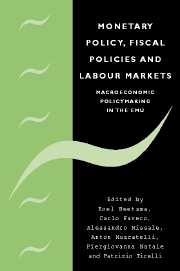Book contents
- Frontmatter
- Contents
- List of figures
- List of tables
- List of contributors
- Acknowledgements
- Editors' introduction
- Part I Monetary policy
- 1 The European Central Bank: a view from across the ocean
- 2 Which measure of inflation should the ECB target?
- 3 An evaluation of alternative targeting rules for the ECB
- 4 Inflation modelling in the euro area
- Part II Fiscal policies
- Part III Labour markets
- Index
3 - An evaluation of alternative targeting rules for the ECB
from Part I - Monetary policy
Published online by Cambridge University Press: 22 September 2009
- Frontmatter
- Contents
- List of figures
- List of tables
- List of contributors
- Acknowledgements
- Editors' introduction
- Part I Monetary policy
- 1 The European Central Bank: a view from across the ocean
- 2 Which measure of inflation should the ECB target?
- 3 An evaluation of alternative targeting rules for the ECB
- 4 Inflation modelling in the euro area
- Part II Fiscal policies
- Part III Labour markets
- Index
Summary
Introduction
Macroeconomic indicators show that countries belonging to the European Monetary Union are at different points in the business cycle. In the month of September 2001, the average inflation rate in the EMU area was 2.6%, but there was a great deal of variance. Greece, Ireland, the Netherlands and Portugal had inflation rates above 4% while France had the lowest inflation rate, 2.2%. At the same time, the GDP of the area increased by 0.5% during the first quarter of 2001, but with a negative growth in Finland, the Netherlands and Portugal.
How should the European Central Bank (ECB) conduct overall monetary policy in this varied environment? The Maastricht Treaty is not silent on this issue. The primary objective of the ECB is that of maintaining price stability. Eventually, the monetary policymaker is permitted to stimulate the growth of the different regions, but only without jeopardising the goal of price stability.
The first bulletin of the ECB (January 1999) explicitly states that one of the main arguments for price stability is that it ‘improves the transparency of the relative price mechanism thereby avoiding distortions and helping to ensure that the market will allocate real resources efficiently both across uses and across times. A more efficient allocation will raise the productive potential of the economy.’
The architects of the European Monetary Union specified a quantitative target to measure deviations from the price stability goal.
- Type
- Chapter
- Information
- Monetary Policy, Fiscal Policies and Labour MarketsMacroeconomic Policymaking in the EMU, pp. 31 - 58Publisher: Cambridge University PressPrint publication year: 2004
- 1
- Cited by



